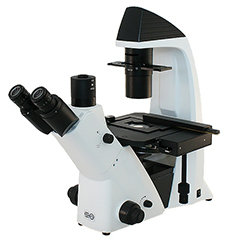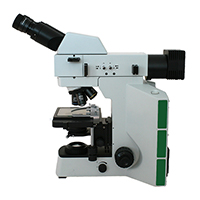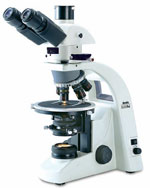
What are the Different Microscope Types and Their Uses?
There are a number of different types of microscopes and each of them solves unique problems. Below you will find information on the five different microscope types along with the applications for each microscope and just who might use each instrument. Below each description of the microscope and its use is an image that was captured using that particular microscope.
5 Different Types of Microscopes:
- Stereo Microscope
- Compound Microscope
- Inverted Microscope
- Metallurgical Microscope
- Polarizing Microscope
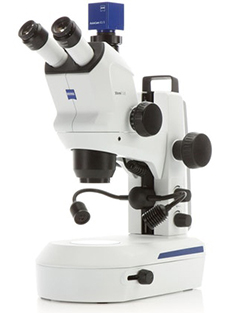
Stereo Microscopes
Stereo microscopes are used to look at a variety of samples that you would be able to hold in your hand. A stereo microscope provides a 3D image or "stereo" image and typically will provide magnification between 10x - 40x. The stereo microscope is used in manufacturing, quality control, coin collecting, science, for high school dissection projects, and botany. A stereo microscope typically provides both transmitted and reflected illumination and can be used to view a sample that will not allow light to pass through it.
The following are samples often viewed under a stereo microscope: coins, flowers, insects, plastic or metal parts, printed circuit boards, fabric weaves, frog anatomy, and wires.

This image of a penny was captured under the a coin collecting stereo zoom microscope at 20x magnification.
Compound Microscopes
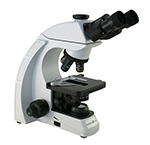 A compound microscope may also be referred to as a biological microscope. Compound microscopes are used in laboratories, schools, wastewater treatment plants, veterinary offices, and for histology and pathology. The samples viewed under a compound microscope must be prepared on a microscope slide using a cover slip to flatten the sample. Students will often view prepared slides under the microscope to save time by eliminating the slide preparation process.
A compound microscope may also be referred to as a biological microscope. Compound microscopes are used in laboratories, schools, wastewater treatment plants, veterinary offices, and for histology and pathology. The samples viewed under a compound microscope must be prepared on a microscope slide using a cover slip to flatten the sample. Students will often view prepared slides under the microscope to save time by eliminating the slide preparation process.
The compound microscope can be used to view a variety of samples, some of which include: blood cells, cheek cells, parasites, bacteria, algae, tissue, and thin sections of organs. Compound microscopes are used to view samples that can not be seen with the naked eye. The magnification of a compound microscope is most commonly 40x, 100x, 400x, and sometimes 1000x. Microscopes that advertise magnification above 1000x should not be purchased as they are offering empty magnification with low resolution.

This image of mushroom spores was captured under a compound biological microscope at 400x magnification.
Inverted Microscopes
Inverted microscopes are available as biological inverted microscopes or metallurgical inverted microscopes. Biological inverted microscopes provide magnification of 40x, 100x and sometimes 200x and 400x. These biological inverted microscopes are used to view living samples that are in a petri dish. An inverted microscope allows the user to place the petri dish on a flat stage, with the objective lenses housed beneath the stage. Inverted microscopes are used for in-vitro fertilization, live cell imaging, developmental biology, cell biology, neuroscience, and microbiology. Inverted microscopes are often used in research to analyze and study tissues and cells, and in particular living cells.
Metallurgical inverted microscopes are used to examine large parts at high magnification for fractures or faults. They are similar to biological inverted microscope in the magnification provided, but one primary difference is that the samples are not placed in a petri dish, but rather a smooth side of the sample must be prepared so it can lay flat on the stage. This smooth sample is polished and is sometimes referred to as a puck.
Metallurgical Microscopes
Metallurgical microscopes are high power microscopes designed to view samples that do not allow light to pass through them. Reflected light shines down through the objective lenses providing magnification of 50x, 100x, 200x, and sometimes 500x. Metallurgical microscopes are utilized to examine micron level cracks in metals, very thin layers of coatings such as paint, and grain sizing.
Metallurgical microscopes are utilized in the aerospace industry, the automobile manufacturing industry, and by companies analyzing metallic structures, composites, glass, wood, ceramics, polymers, and liquid crystals.

This image of a piece of metal with scratches on it was captured under a metallurgical microscope at 100x magnification.
Polarizing Microscopes
Polarizing microscopes use polarized light along with transmitted and, or reflected illumination to examine chemicals, rocks, and minerals. Polarizing microscopes are utilized by geologists, petrologists, chemists, and the pharmaceutical industry on a daily basis.
All polarizing microscopes have both a polarizer and an analyzer. The polarizer will only allow certain light waves to pass through it. The analyzer determines the amount of light and direction of light that will illuminate the sample. The polarizer basically focuses different wavelengths of light onto a single plane. This function makes the microscope perfect for viewing birefringent materials.

This is Vitamin C captured under a polarizing microscope at 200x magnification.
If you are unsure which type of microscope might be best for your application, contact Microscope World.

